|
Women's
Memorial March 2022
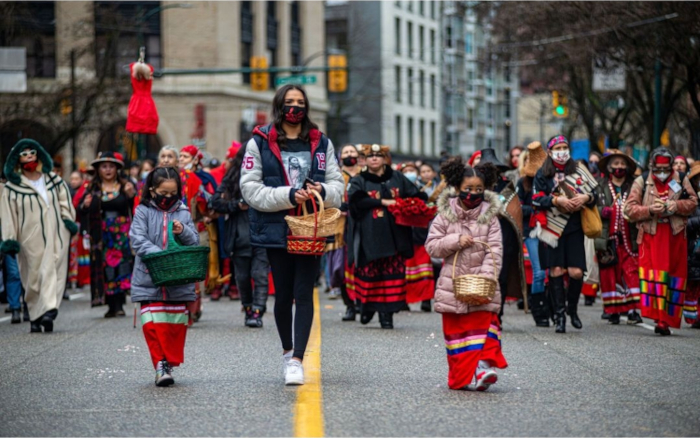
Photo: Camilo Ruiz
The first Women's Memorial March in Vancouver took place in
the early 90's, and I can't imagine how the family members of
the missing women must feel so many years later as they
continue to fight to have the systemic issues that have
contributed to the deaths of thousands of Indigenous women
nationally be addressed.
On my way from the bus I followed behind a grandmother, mother
and her young son who jumped on and off the curb of the
sidewalk laughing and full of excitement. His mom carried a
large embroidered drum bag and wore a long, brightly coloured
skirt. There was a strong scent of sage burning as we headed
towards the crossroads at Main and Hastings. When I got there
I saw hands all around holding large sea shells and some were
fanning the shells with large eagle and raven wings to make
more smoke.
I followed my ears to the centre of the intersection where
drummers were seated under a tent in front of a large drum
that they all were striking in unison creating a powerful beat
that bored deep into my heart and bones. I've heard elders
talk about how the sound of skin drumming emulates the sounds
of our mother's heart's beating when we were in the womb; that
they were first sounds we heard and that we're drawn to them
and they comfort us.
There were other tents set up and hanging from them were the
images and names of women who are no longer, a haunting
reminder of the unsettled spirits that roamed the streets and
alleyways around us.
As the drumming continued we set off down Main St.
**
The first
two times I went to the march I met up with other people I
knew from the Trans Mountain Pipeline resistance movement.
This time I was alone and I brought a drum. I watched more
closely and felt more deeply as we stopped at locations where
women had been found or gone missing. Flowers in red and
yellow were left for remembrance and hope, and ceremony was
held. I felt my body start to shake and tears well up. A woman
started riding through the crowd on a scooter smiling and
wishing everyone a Happy Valentines Day.
I wasn't sure where I would find myself in the crowd. I wasn't
sure if I would use my sigil bedecked Nordic drum or not so I
kept it tucked into my bag and kept myself on the sidelines.
The night before I cried out a river of my personal sorrows so
I could better hold the sorrows of others. Before coming, I
pondered intellectually what my place is in such a space,
being a non-Indigenous person who has had a lot to learn over
the years about the shadow history of these lands. I was also
fighting my social anxieties and naturally nervous
constitution. Those 'first day of kindergarten' feelings came
up and I started feeling the desire to bolt.
A woman next to me started asking me where we were and what
route we would be taking. She came from out of town and didn't
know the area so I told her how she could get back to her car
at the end. She cracked an offensive joke and I couldn't help
laughing. After I was there for a little while my spirit took
over and I felt compelled to start drumming.
As the march progressed, a crowd of people gathered around the
"Gassy Jack" statue in the heart of one of Vancouver's most
touristy neighbourhoods, "Gastown". There had been requests
for the dismantling of the monument several years ago, as a 40
year-old man marrying a 12 year-old Indigenous girl is hardly
something to commemorate.
Hands moved quickly from all angles with battery powered angle
grinders and two ropes were placed around the neck of the
statue. A clearing was made and the statue was toppled in a
very short period of time. In the heat of the moment one of
the main organizers of the march narrowly missed getting
knocked over along with the large metal effigy. Bright red
paint was doused from plastic water bottles and loud speakers
played out the sordid history of Gassy Jack and the
colonization of Vancouver. I stood on the other side of the
street and I remembered the rune that I pulled that morning:
Hagalaz.
I felt light headed after witnessing such a dramatic event so
I hung back until the crowd cleared and took some photos. I
met up with the march again and then we circled back to Main
and Hastings where the Carnegie Centre had hot chocolate
waiting for everyone.
The Chief of the Assembly of First Nations RoseAnne Archibald
spoke and called the Downtown Eastside "ground zero" for
inter-generational trauma and spoke about the need of a
healing path for all. A Nisga’a and Gitxsaan woman, Yvonne,
spoke of her struggles living in the DTES and her own family’s
inter-generational trauma that was rooted in the residential
school system.
At the end we heard from Losah Henry of the Tla'amin Nation,
who I recognized from the Transmountain and Ada'itsx (Fairy
Creek) land protection actions. She spoke about her recent
search for her missing nibling, Bear Henry, and how the RCMP
told her that they wouldn't be bringing them back alive and
that they were holding back with the resources they were
putting into the search. Eventually Bear was found alive after
74 days in the wild and is a story of hope and resilience.
I ran into an acquaintance and was told that many of the
elders who organized the march weren't aware that the Gassy
Jack statue was going to be taken down and there was some
tension around that. I thought about the movie "Do the Right
Thing" by Spike Lee and the opposing viewpoints of Martin
Luther King Jr. and Malcolm X when it comes to enacting
justice.
The march continued down Hastings Street and there were vigils
held at more landmarks where women were taken. There was more
ceremony at a totem pole in Oppenheimer park with a large
black raven on top that is meant to honour "lives that
otherwise may have gone unrecorded." From there we went to the
Japanese Hall for more singing, drumming and food; and at the
end a woman did a sun dance song.
I decided to head back down to the Gassy Jack monument and saw
that the crimson covered statue was missing (the city hauled
it away on a flat bed truck). There were reporters there from
CTV and as they were getting ready to do a live broadcast, a
man approached the makeshift women's memorial that had been
left in the statues wake and tore away one of the homemade
posters left by a family member. He was screaming "this is
fucking sick!" and "fucking bullshit!". Another woman grabbed
the poster and put it back up and the man stormed off. I
thought about further backlash that might happen. When Captain
Cook was beheaded and thrown into the harbour in Victoria,
someone reacted by setting a nearby totem pole on fire.
As someone who has never felt in the least bit patriotic, it’s
difficult to understand why people would even care. Yet I’ve
come to recognize that a large swath of people on these lands
strongly identify with the vague and rootless notion of a
concrete “Canadian” national identity.
I think it's also important to note that the destruction of
monuments seems to get the general public a lot more riled up
and angry than the crisis of Indigenous women who have gone
missing or been murdered, often brutally, leaving families
devastated for generations; or the ongoing inter-generational
trauma and systemic issues that disporportionately affect
Indigenous people.
These issues are ongoing and don't get the atention they
deserve.
❤❤❤
• Pickton
Trial: Who Were the Victims?
• The
Unnatural and Accidental Women
• Community
Resource Guide for the Missing and Murdered Indigenous Women
• Residential
School Survivors and Family
1-800-721-0066
The Residential Schools Crisis Line is available 24-hours a
day for anyone experiencing pain or distress as a result of
his or her Residential school experience.
• Crisis
Services Canada
(for Indigenous and non-Indigenous persons)
OR
• Good
Samaritans
I like them because you can also email them for support at
jo@samaritans.org – though there is some delay in comparison
to phoning
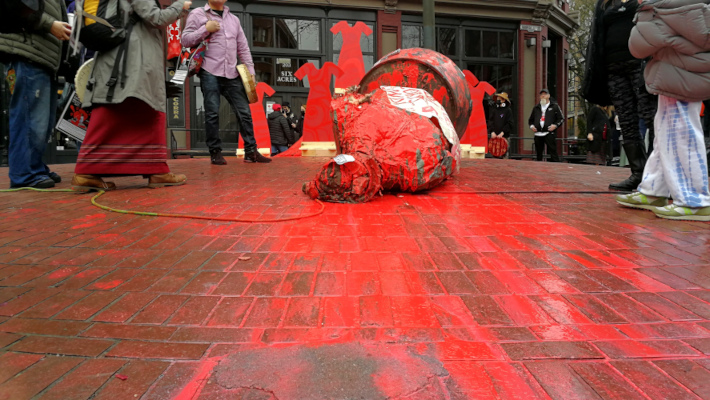
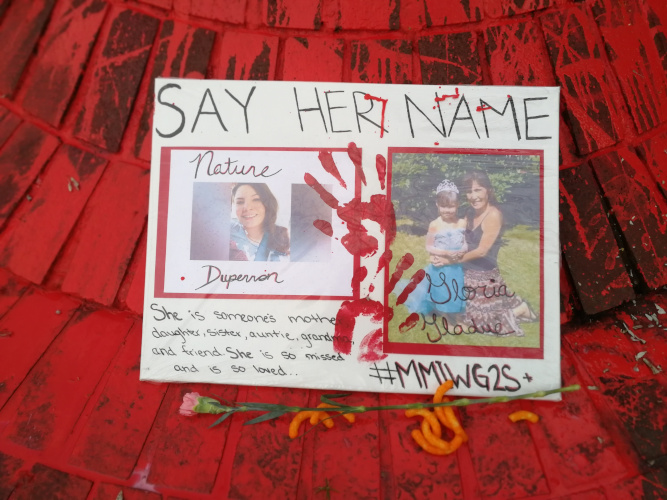
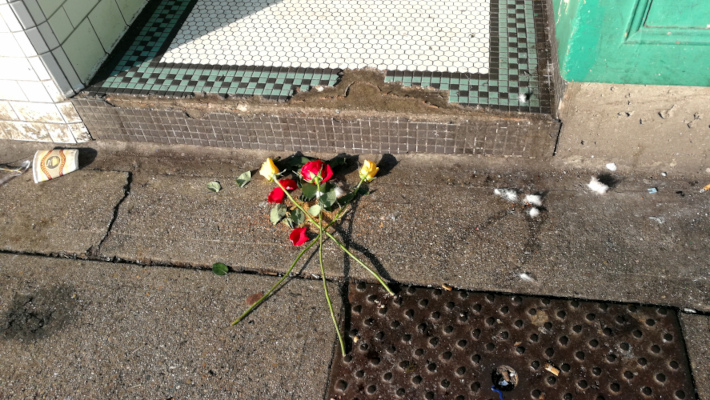

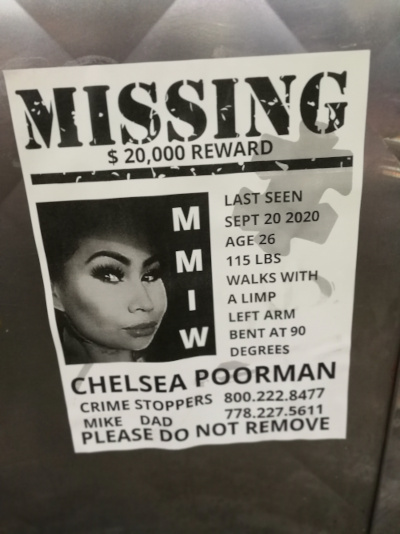

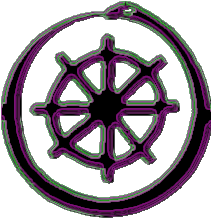

|








